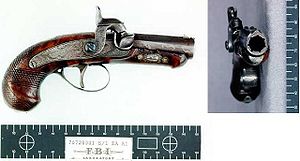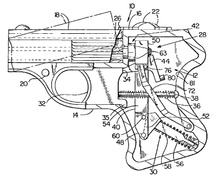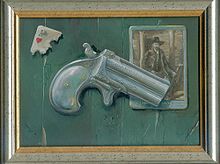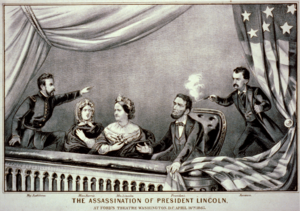| Abilene, Kansas from Wikipedia
Abilene began as a stage coach stop in 1857, established
by Timothy Hersey and named from a passage in the Bible, meaning "city
of the plains". The town grew quickly when Joseph G. McCoy decided to use
the town for the location of his stockyards. Abilene became the very first
"cow town" of the west.
With the railroad pushing west, cattle traders soon came
to use Abilene as the largest stockyards west of Kansas City. The Chisholm
Trail ended in Abilene, bringing in many travelers and making Abilene one
of the wildest towns in the west.
Town marshal Tom "Bear River" Smith was initially successful
policing Abilene, often using only his bare hands. He survived two assassination
attempts during his tenure. However, he was murdered and decapitated on
November 2, 1870. Smith wounded one of his two attackers during the shootout
preceding his death, and both suspects received life in prison for the
offense. He was replaced by Wild Bill Hickok in April 1871. Hickock's time
as marshal was short lived. While standing off a crowd during a street
brawl, gambler Phil Coe took two shots at Hickock, who returned fire killing
Coe, but then accidentally shot his friend and deputy, Mike Williams, who
was coming to his aid. He lost his job two months later in December.
In 1880 Conrad Lebold built what the newspapers called
the finest house west of Topeka. Lebold was one of the early town developers
and Bankers from 1869 through 1889. The Hersey dugout can still be seen
in the cellar of the Lebold Mansion.
In 1887, Atchison, Topeka and Santa Fe Railway built a
branch line from Neva (3 miles west of Strong City) through Abilene to
Superior, Nebraska. In 1996, the Atchison, Topeka and Santa Fe Railway
merged with Burlington Northern Railroad and renamed to the current BNSF
Railway. Most locals still refer to this railroad as the "Santa Fe".
In 1890, Dr. A.B. Seelye founded the A.B. Seelye Medical
Company. Seelye developed over 100 products for the company including "Wasa-Tusa",
an Indian name meaning to heal.
Abilene became home to Dwight D. Eisenhower when his family
moved to Abilene from Denison, Texas in 1892. Eisenhower attended elementary
school through high school in Abilene, graduating in 1909. The Dwight D.
Eisenhower Presidential Library and Museum is located in Abilene. It is
now the burial site of President Eisenhower, his wife, Mamie, and their
first born son Doud Dwight.
|
| Thomas J. Smith from Wikipedia
A town marshal of Old West cattle town Abilene, Kansas.
| Early life
Little is known of Smith's youth, although he was well
known as a good man in a fight, had a reputation as a tough man, and had
been a professional middleweight boxer. Originally from New York, he had
served as a lawman in Kit Carson, Colorado, a few small towns in Wyoming,
and as a police officer in New York City prior to his move to Kansas. While
working as a police officer in New York City, Smith was involved in the
accidental killing of a 14-year-old boy in 1868, after which he resigned
and began working for Union Pacific Railroad in Nebraska.
Smith received the nickname "Bear River" due to a stand
he made during a skirmish with vigilantes while serving as a lawman in
Wyoming. A vigilante group had lynched a railroad employee who was suspected
of murder. Soon afterward, railroad employees retaliated against the vigilantes,
resulting in most of the small town of Bear River City, Wyoming being burned
to the ground, and a shootout between town citizens and mob members erupted.
Smith stood both sides off, until troops from Fort Bridger arrived and
imposed martial law. Bear River City soon became deserted, another railroad
ghost town.
Smith has been described as having been a handsome man,
with a thick mustache, and a trait of an almost fearless nature. There
are a number of examples indicating that Smith would refuse to back down,
despite whatever odds might be against him.
Marshal of Abilene
Prior to Smith's appointment as Abilene Marshal, two St.
Louis, Missouri policemen had been hired. The town of Abilene was, at the
time, a wild cattle town, and the crime rate had |

Thomas James Smith
known as Tom "Bear River" Smith
(12 June 1830 - 2 November 1870) |
increased almost overnight, beginning in 1867, to the point
where murder and shootings were commonplace. The town had numerous saloons
and brothels, and up until that point a police force was all but nonexistent.
The two St. Louis lawmen resigned before their first day of service was
complete. The mayor of Abilene, Theodore Henry, sent for Smith in late
1869, who came highly recommended due to a reputation he had built while
working alongside lawman Pat Desmond in Kit Carson, Colorado.
Smith was also commissioned as a Deputy US Marshal, and
was insistent that he could police Abilene using his hands and wit rather
than using guns. For a time, he was somewhat successful, although he was
forced to use guns in the course of his duty on a few occasions. On one
occasion, shortly after taking office, Smith singlehandedly overpowered
two men known for their bad temperament, "Big Hank" Hawkins and his partner,
known only as "Wyoming Frank". Smith banished them both from Abilene, after
beating them both at the same time using only his bare hands. However,
being the marshal of a town like Abilene at that time proved to be a dangerous
job to have. He implemented a law of "no guns in town limits", which was
extremely unpopular with many of the cowboys that drifted through town,
and over the next two months Smith survived two assassination attempts.
Several other incidents and arrests led him to develop a solid reputation,
and he became widely respected and admired by the Abilene citizens.
On 2 November 1870, Smith and a temporary deputy, believed
to be named James McDonald, attempted to serve a warrant on two local farmers,
Andrew McConnell and Moses Miles. The two men were wanted in connection
with the murder of another Abilene man, John Shea. McDonald and Smith located
the suspects in a small settlement ten miles outside of Abilene. A gunfight
erupted, in which Smith was badly wounded in the chest. Smith returned
fire and wounded McConnell. His deputy fled the scene, and as Smith lay
wounded, Moses Miles hit him with the butt of a rifle, then took an axe
and decapitated him.
McConnell and Miles were captured and arrested in March
1871, and they were both sentenced to life in prison. Smith was buried
in Abilene, and a huge tombstone was erected with a plaque to honor his
service and ultimate sacrifice. Smith was replaced as marshal by legendary
lawman and gunfighter "Wild Bill" Hickock. Dwight Eisenhower reportedly
considered Smith a personal hero, and is reported to have visited Smith's
gravesite on numerous occasions.
|
Derringer from Wikipedia
| The term derringer is a genericized misspelling
of the last name of Henry Deringer, a famous 19th-century maker of small
pocket pistols. Many copies of the original Philadelphia Deringer pistol
were made by other gun makers worldwide, and the name was often misspelled;
this misspelling soon became an alternate generic term for any pocket pistol,
along with the generic phrase palm pistol Deringer's competitors invented
and used in their advertising. The original Deringer pistol was a single-shot
muzzleloading pistol; with the advent of cartridge firearms, pistols began
to be produced in the modern form still known as a derringer. |

An original Philadelphia Deringer made by Henry Deringer.
This was the pocket pistol used by John Wilkes Booth
in the Abraham Lincoln Assassination. |
Design

Magazine of the four-shot COP derringer patent 4,407,085
. |
A derringer is generally the smallest
usable handgun of a given caliber. They were frequently used by women,
because they are easily concealable in a purse or as a stocking gun. Such
weapons designed specifically for women were called "muff pistols", due
to their compact size enabling them to be carried in a muff. Derringers
are not repeating firearms—repeating mechanisms such as used on semi-automatic
handguns or revolvers would add significant bulk to the gun, defeating
the purpose. The original cartridge derringers held only a single round,
usually a pinfire or rimfire .40 caliber cartridge, with the barrel pivoted |

2 barrel Remington derringer |
sideways on the frame to allow access to the breech for reloading.
The famous Remington derringer design doubled the capacity, while maintaining
the compact size, by adding a second barrel on top of the first and pivoting
the barrels upwards to reload. Each barrel then held one round, and a cam
on the hammer alternated between top and bottom barrels. The Remington
derringer was in .41 Rimfire caliber and achieved wide popularity. The
.41 Rimfire bullet moved very slowly, at about 425 feet per second (a modern
.45 ACP travels at 850 feet per second). It could be seen in flight, but
at very close range, such as at a casino or saloon card table, it could
easily kill. The Remington derringer was sold from 1866 to 1935.
Even with the advent of smaller, higher-powered cartridges
made possible by the use of smokeless powder rather than the black powder
used in the 19th century and before, the classic Remington design remained
popular; a Remington-pattern derringer in .38 Special is still smaller
than the most compact .25 ACP semiautomatic, and provides superior terminal
ballistic performance to the .25 ACP. While the classic Remington design
is a single action, manufacturers have also made double action derringers,
including some four-shot models, with the barrels stacked in a 2 x 2 block.
The COP 357 Derringer, made in Boise, Idaho, provided four shots of .357
Magnum in a package not much larger than a .25 ACP automatic, and was significantly
more compact than a similar revolver. The COP derringer was invented by
Robert Hillberg and closely resembled his earlier work on insurgency weapons.
A related design, often grouped with derringers since
it fits no other standard classification, is the Semmerling pistol. It
is a five-shot, .45 ACP pistol with a manual repeater: the barrel mechanism
is manually pulled forward to eject the fired round, then pushed back to
chamber the next round. These pistols were originally built for the United
States Army, and the few available on the civilian market are highly sought
after due to their unique combination of high power, large capacity, and
tiny size. Another military pistol that is truly a derringer design is
the FP-45 Liberator, a .45 ACP insurgency weapon dropped behind Axis lines
in World War II.
The Remington derringer design is still in manufacture
as of 2010. Bond Arms, Cobra Arms and American Derringer all manufacture
the over/under derringer in a variety of calibers from .22 long rifle to
.45 Long Colt. The current production of derringers are used by Cowboy
Action Shooting reenactors as well as a concealed-carry weapon. It is the
smallest handgun that is capable of handling the largest ammunition. Some
favor the derringer as a concealed carry weapon because of its size as
well as the swiftness of putting it into action. Critics believe it is
not an adequate weapon for self-defense since the derringer possesses a
two-shot capacity.
Derringer manufacturing history
Remington Model 95 over-under derringers were manufactured
from 1866 until 1935, in several rimfire calibers, the most common of which
was .41 rimfire. They were never serially numbered, but were numbered within
production batches. Batches apparently went from 500 to 5,000 guns per
batch depending on demand. There were 3 trademarks — "E. Remington &
Sons, Ilion, NY", "Remington Arms Co.", and "Remington-UMC". The 1st model
derringer had a hollow rather than skeleton butt and no extractor. It was
marked "E. Remington & Sons, Ilion, NY". The 2nd had a skeleton butt
but no extractor and the same trademark. The 3rd model had a 2-part extractor
and same trademark. The 4th model had a one piece extractor and all 3 trademarks.
Remington went bankrupt in 1881. In 1883 the assets were
bought by Hartley & Graham of New York, a major firearms wholesaler.
Hartley & Graham renamed the company Remington Arms Co. and marked
all Remington firearms with that trademark until 1910. In 1910 Hartley
& Graham merged Remington with Union Metallic Cartridge Company and
changed the trademark to "Remington-UMC". In 1921 Hartley & Graham
sold Remington and UMC to the DuPont company. DuPont separated Remington
and UMC and marked all Remington weapons except the derringer with Remington
Arms Co. The derringer continued to be marked Remington-UMC until production
ceased in 1935.
Hollow-butt derringers were made only in 1866. Skeleton
butt without extractor from 1866-67. Two part extractor thru '69. One part
extractor thereafter. Derringers with one part extractors marked E. Remington
& Sons, Ilion, NY—1870-1881. Remington Arms Co. mark—1883-1910. Remington-UMC—1910-1935.
Philadelphia Deringer
A Philadelphia Deringer is a small percussion handgun
designed by Henry Deringer (1786–1868) and produced from 1852 through 1868.
A popular concealed carry handgun of the era, this pocket pistol design
was widely copied by competitors, sometimes down to the markings. Over
time, the common misspelling "derringer" that was used on copies of Deringer's
design has come to refer to any small-sized, usually large-caliber handgun
that is neither a semi-automatic pistol nor a revolver.
For loading a Philadelphia Deringer, one would typically
fire a couple of percussion caps on the handgun, to dry out any residual
moisture contained in the tube or at the base of the barrel, to prevent
a subsequent misfire. One would then remove the remains of the last fired
percussion cap and place the handgun on its half-cock notch, pour 15 to
25 grains of blackpowder down the barrel, followed by ramming a patched
lead ball down onto the powder, being very careful to leave no air gap
between the patched ball and the powder, to prevent the handgun from exploding
when used. (The purpose of the patch on the ball was to keep the ball firmly
lodged against the powder, to avoid creating what was called a "short start"
when the ball was dislodged from being firmly against the powder.) A new
percussion cap would then be placed on the tube (what today would be called
a nipple), and the gun was then loaded and ready to fire. (The half-cock
notch prevented the hammer from falling if the trigger were bumped accidentally
while carrying the handgun in one's coat pocket.) Then, to fire the handgun,
a user would fully cock the hammer, aim, and squeeze the trigger. Upon
a misfire, the user could fully re-cock the hammer, and attempt to fire
the handgun once more, or, equally common, switch to a second Deringer.
Accuracy was highly variable; although front sights were common, rear sights
were less common, and some Philadelphia Deringers had no sights at all,
being intended for point and shoot use instead of aim and shoot, across
Poker-table distances. Professional gamblers, and others who carried regularly,
often would fire and reload daily, to decrease the chance of a misfire
upon needing to use a Philadelphia Deringer.
A common magician trick from this era called the "bullet
catch" was commonly done with a Philadelphia Deringer without applying
a patch on the lead ball. The magician would, with great fanfare, go through
the motions of pouring a small amount of blackpowder down the barrel, followed
by inserting a very light overpowder wad, and by then dropping an intentionally-undersized
lead ball down the barrel, unpatched, after showing it carefully to the
audience, and placing a cap on the tube. Prior to handing the gun to another
person, the magician would tip the Philadelphia Deringer, causing the lead
ball to drop into a closed palm. The accomplice or a volunteer from the
audience would then aim the Philadelphia Deringer at the magician, squeeze
the trigger, the gun would fire, a large cloud of blackpowder smoke would
appear, and the magician would, with great fanfare, have "caught" a bullet
out of the air, holding the palmed bullet between his fingers. The trick
was highly dangerous, as the overpowder could kill at short distances,
and a real bullet or other small object, could be dropped down the barrel
before the handgun was fired, for a volunteer or accomplice intent on malice.
| Henry Deringer's production records, and contemporaneous
records of his imitators, indicate that these pistols were almost always
sold in matching pairs. (A typical price was $15 to $25 for a pair, with
silver-inlaid and engraved models selling at higher prices.) The choice
of buying a pair, in part, was to compensate for the limited power of a
single-shot, short-barreled pistol, and to compensate for a design considerably
less reliable than subsequent cartridge derringer designs. Original Deringers
are almost never found still in their matched pairs today.
Initially popular with military officers, the Deringer
became widely popular among civilians who wished to own a small and easily
concealable pistol for self defense.
In total, approximately 15,000 Deringer pistols were manufactured.
All were single barrel pistols with back action percussion locks, typically
.41" rifled bores, and walnut stocks. Barrel length varied from 1.5" to
6", and the hardware was commonly a copper-nickel alloy known as "German
silver". (The back action lock was a later, improved design among locks,
which had its spring and mechanism located behind the hammer, where it
was thereby protected from dirt, fired cap residue, and gunpowder residue
unlike earlier front action locks that had their springs and mechanism
located directly in the path of such residue in front of the hammer, under
the tube.) |
.
Currier and Ives depiction of Lincoln's assassination
with a Philadelphia Deringer. L-to-r: Henry Rathbone,
Clara Harris, Mary Todd Lincoln, Abraham Lincoln,
and John Wilkes Booth |
Because of their small size and easy availability, Deringers
sometimes had the dubious reputation of being a favored tool of assassins.
The single most famous Deringer used for this purpose was fired by John
Wilkes Booth in the assassination of Abraham Lincoln. Booth's Deringer
was unusual in that the rifling twisted counterclockwise (left-handed twist),
rather than the typical clockwise twist used on most Philadelphia Deringers.
|
All articles submitted to the "Brimstone
Gazette" are the property of the author, used with their expressed permission.
The Brimstone Pistoleros are not
responsible for any accidents which may occur from use of loading
data, firearms information, or recommendations published on the Brimstone
Pistoleros web site. |
|